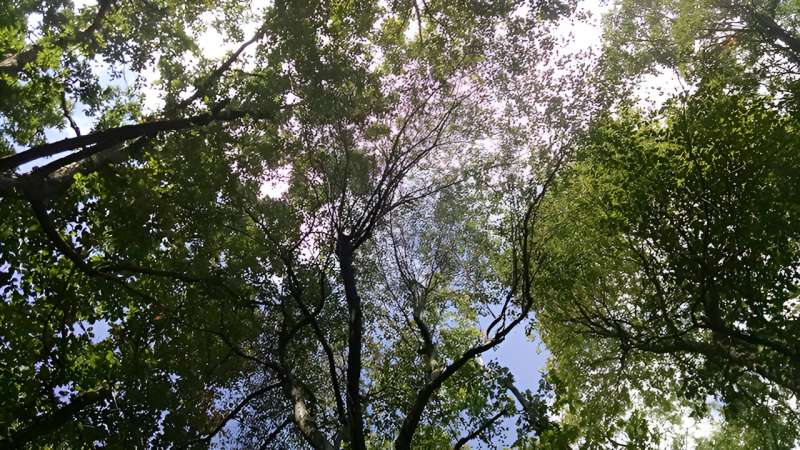This article has been reviewed according to Science X's editorial process and policies. Editors have highlighted the following attributes while ensuring the content's credibility:
fact-checked
trusted source
proofread
Complex tree canopies found to help forests recover from moderate disturbances

Extreme events wipe out entire forests, dramatically eliminating complex ecosystems as well as local communities. Researchers have become quite familiar with such attention-grabbing events over the years. They know less, however, about the more common moderate-severity disturbances, such as relatively small fires, ice storms, and outbreaks of pests or pathogens.
"Since they're more common, they're probably playing a larger role in the ecosystem than we might have appreciated before," said Brady Hardiman, associate professor of forestry and natural resources and environmental and ecological engineering at Purdue University's College of Agriculture.
"At any given time, a huge fraction of the forested landscape is undergoing or regrowing from a moderate-severity disturbance, which took out some of the trees but not all of them. The forest is not regrowing from scratch."
A paper published in the Journal of Ecology by Purdue University researchers and their co-authors has identified how moderate-severity disturbances leave different patterns of change in the forest canopy structure. Hardiman and his colleagues based their findings on lidar (light detection and ranging) data collected at five sites of the National Science Foundation's National Ecological Observatory Network in New Hampshire, Massachusetts, Virginia, and Tennessee.
"The most interesting finding from this study is that the multitemporal lidar data can detect subtle signals of the disturbances," said the paper's lead author, Dennis Heejoon Choi, a Purdue postdoctoral scientist.
NEON began collecting data about ten years ago. Repeat observations at specific forest sites of the type that NEON collects are still relatively rare, especially on a continental scale.
"NEON is a big sampling initiative," said co-author Elizabeth LaRue, assistant professor of biological sciences at the University of Texas at El Paso. "It's a big deal that now we have data to do something like this over time."
Forest canopy structural dimensions include height, openness, density, and complexity. Previous research by Hardiman and others has documented that structurally complex canopies absorb more light and that their complexity is linked to essential ecosystem functions. These include nutrient cycling, providing shelter and nutrients to organisms, and biodiversity.
Comparing an old-growth forest to a Christmas tree farm offers a simple contrast in complexity, noted LaRue, a Purdue Ph.D. alumna. Trees on a farm, planted in rows at about the same time, are all approximately the same age and height. An old-growth forest, meanwhile, shows far more variation with trees of different sizes, ages, species, and shapes.
"You can measure things that might be equivalent to a block of cheese," she said. "A block of Swiss cheese would be more complex than, say, a block of cheddar. Some of the metrics we use essentially measure how many holes you have in your block of forest."
The researchers analyzed the differences between press and pulse disturbances, discrete events compared to those that occur over a longer period. The co-authors looked for patterns in changes to canopy structure following disturbances. They found that forests with canopy structures of more complexity seemed better able to withstand and recover from the disturbances.
"Canopy structure is something we can modify through management activities," Hardiman said. "Managing forests to promote structural complexity could make them more resilient to a variety of disturbances in ways that allow our forests to continue growing following those disturbances."
Wrangling the NEON data was a computationally intensive process that required the resources of Purdue's Rosen Center for Advanced Computing. The process included accounting for the changes in lidar technology and differing sensor configurations used over the years. Newer lidar systems with stronger beams generate denser point clouds—the 3D data sets that represent the shape of the forest canopies.
"We tried to homogenize the point density equally year by year to make comparative metrics," Choi said. The challenge was to balance the enhanced measurement capabilities of newer sensors with the need for consistency and comparability across time, he noted.
More information: Dennis Heejoon Choi et al, Short‐term effects of moderate severity disturbances on forest canopy structure, Journal of Ecology (2023). DOI: 10.1111/1365-2745.14145
Provided by Purdue University


















